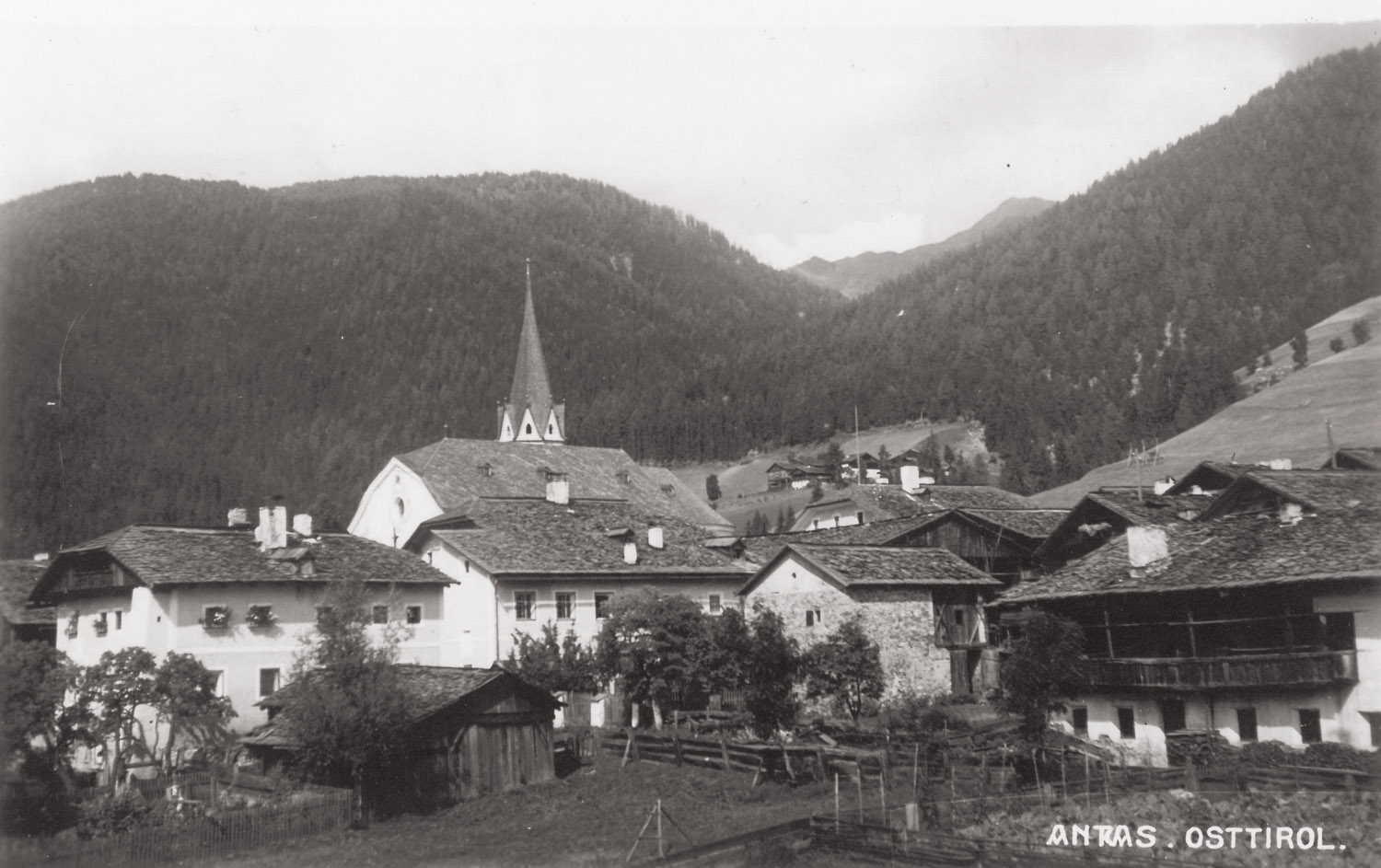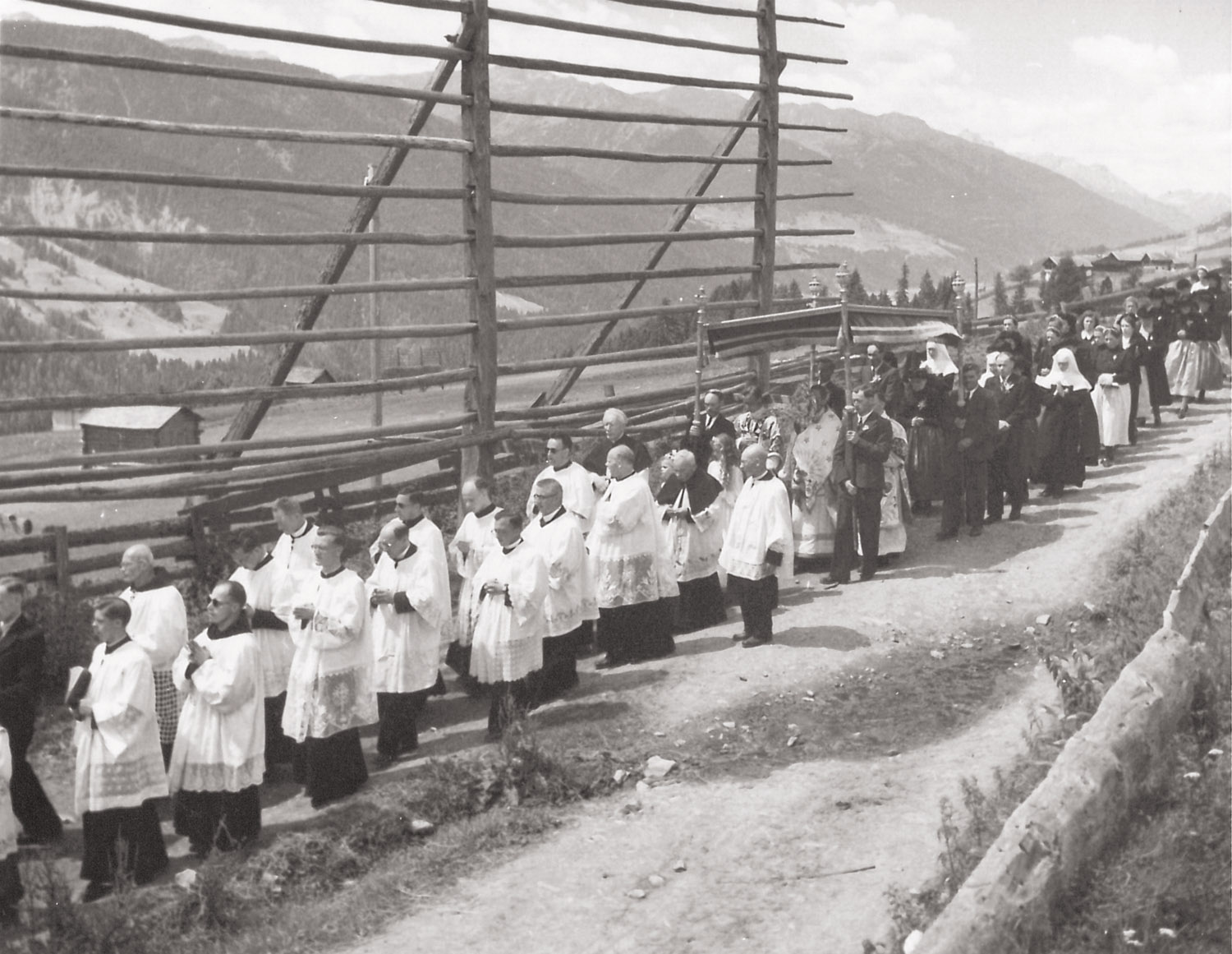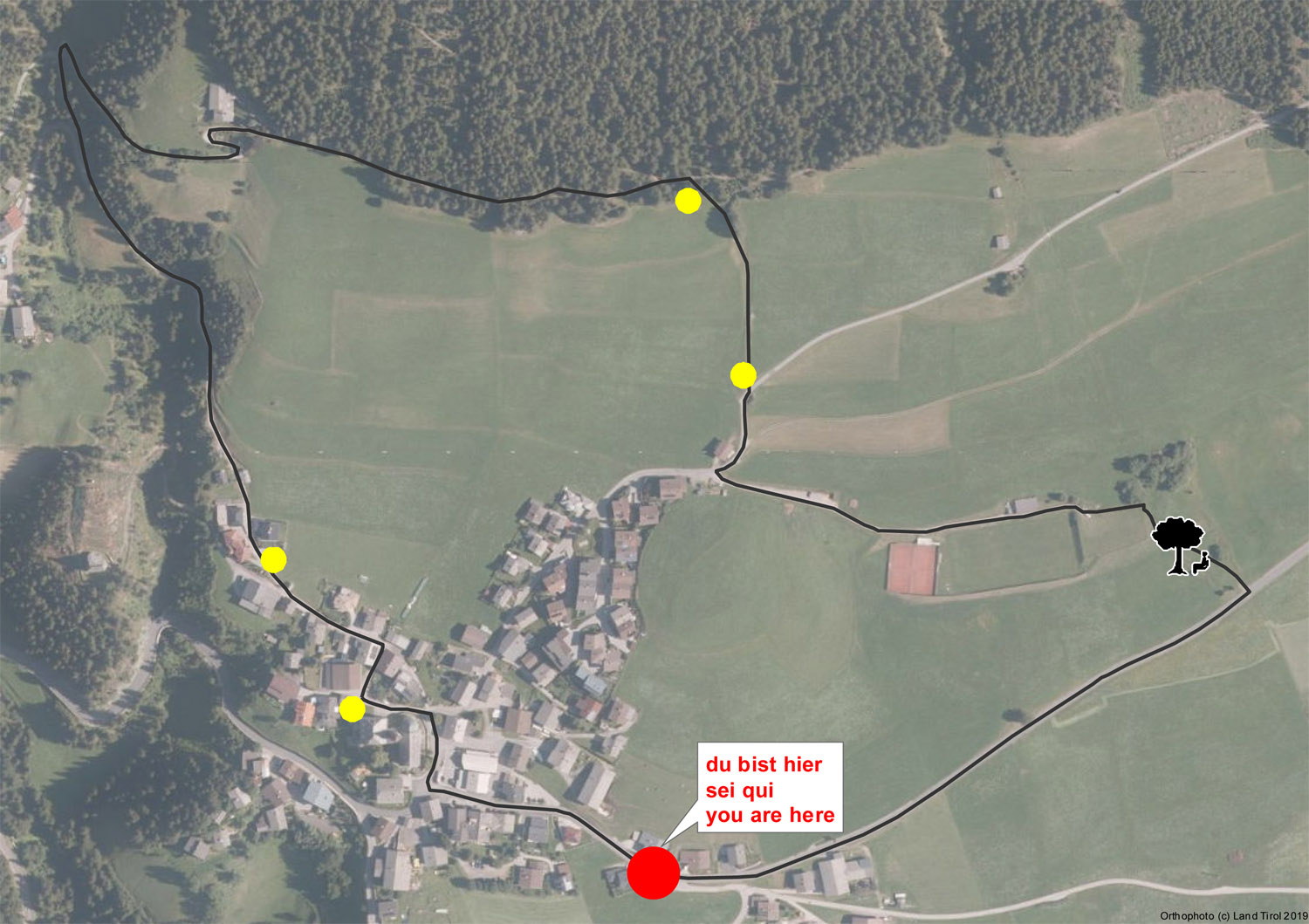
Ansicht um 1930, Foto: Gemeindearchiv Anras / Dina Mariner
Die Abbildung zeigt den ehemaligen Charakter des Haufendorfes Anras mit dicht und teilweise regellos aneinandergebauten Häusern. Sämtliche, im Vordergrund stehende Bauwerke existieren nicht mehr und sind als historisch zu betrachten. Besonders die große Anzahl an Obstbäumen und kleinen Hausgärten im Vordergrund zeigt den ehemaligen Drang zur Selbstversorgung.
Von links nach rechts:
Im Vordergrund: Majörger Feuerhaus (Feuerhaus bedeutet Wohnhaus), ehemaliges Schulhaus, Unterlochmair Kornkasten, Zöschger Haus
Im Hintergrund: Kirche mit Kirchturm, Widum, Pfarrer Futterhaus, Unterlochmair, Bodner
L’illustrazione mostra di un tempo carattere dell’agglomerato con densamente popolato e le case senza alcuna di distanza fra loro. Tutti gli edifici in primo piano non esistono più. Soprattutto il gran numero di alberi da frutto e piccoli giardini di case in primo piano mostra la necessità di autosufficienza.
Da sinistra a destra:
Nel primo piano: casa del fuoco di Majörger (casa del fuoco vuol dire casa d’abitazione, perché lì si cucinava dal fuoco), scuola di una volta, granaio di Unterlochmair, Casa Zöschger
In sfondo: chiesa con campanile, casa del pastore, magazzino del pastore, Unterlochmair, Bodner
The illustration shows the former character of the cluster village of Anras with densely and partially irregularly built houses. All the buildings in the foreground no longer exist. Especially the large number of fruit trees and small gardens in the foreground shows the necessity for self-sufficiency at that time.
From left to right:
In the foreground: Majörger firehouse (firehouse means residential building), former schoolhouse, Unterlochmair granary, Zöschger house
In the background: church with steeple, rectory, priest feeding house, Unterlochmair, Bodner

Ansicht 1950, Foto: Gemeindearchiv Anras / Dina Mariner
Die historische Abbildung zeigt eine Prozession an der Abzweigung Hofangerweg, vorbei an der ehemaligen Zehentharpfe. Im Hintergrund links zu sehen ist die Mascher Schupfe.
Harpfen sind Gerüste aus Holz, welche zum Trocknen von Getreidegarben verwendet werden. Aufgrund der klimatischen Gegebenheiten Osttirols musste das Getreide öfters vor seiner endgültigen Reife geschnitten werden. Die halbreifen Garben wurden zum endgültigen Abreifen nachgetrocknet. Dazu diente die Harpfe.
Sie besteht aus zwei oder mehreren Holzsäulen, an denen einige quer verlaufende Stangen aufliegen. Diese Querstangen tragen das geschnittene Korn. Das Feld zwischen zwei Stangen nennt man Tor (Törl). Es gibt ein-, zwei- und dreitorige Harpfen sowie sogenannte Doppelharpfen, welche über ein Dach miteinander verbunden sind.
Die Konstruktion und Größe der Harpfen variiert in den verschiedenen Talschaften Osttirols, sodass wir von sog. Harpfenlandschaften sprechen können. Durchschnittlich reichte das Tor einer Harpfe für etwa 14 – 16 Ar Ackerfläche.
L'immagine mostra una processione all'incrocio Hofangerweg oltre la “Zehentharpfe”. Sullo sfondo si può vedere il fienile Mascher.
Harpfen sono impalcature di legno utilizzate per secchi filari di grano. A causa delle condizioni climatiche del Osttirol, il grano doveva essere tagliato prima della sua maturità finale. I covoni semi-maturi furono asciugati per la maturazione finale.
Consiste in due o più colonne di legno su cui poggiano alcuni pali trasversali. Queste sbarre portano i cereali tagliati. Il campo tra due sbarre si chiama “Törl”. Ci sono Harpfen da uno-due o tre gate, così come le cosiddette Doppelharpfen, che sono collegate da un tetto.
La costruzione e le dimensioni di Harpfen si variano nelle diverse valli del Osttirol. In media, il cancello di Harpfe per 14-16 acri di terreno coltivabile.
The picture shows a procession at the Hofangerweg junction past the former Zehentharpfe. In the background left you can see the Mascher Schupfe.
Harpfen are scaffolds made of wood, which are used to dry grain sheaves. Due to the climatic conditions of East Tyrol, the grain had to be cut before its final ridge. The semi-ripe sheaves were dried again for final maturation.
It consists of two or more wooden columns on which some crosswise running bars are resting. These transverse bars carry the cut grain. The field between two columns is called a gate (“Törl”). There are Harpfen with one, two and three gates, as well as so-called Doppelharpfen which are connected to each other by a roof.
The construction and size of the Harpfen vary in the different valleys of East Tyrol. On average the gate of a Harpfe is sufficient for about 14-16 ares of arable land.

 Abfallratgeber
Abfallratgeber Tierkadaver - Annahmezeiten/Kosten
Tierkadaver - Annahmezeiten/Kosten